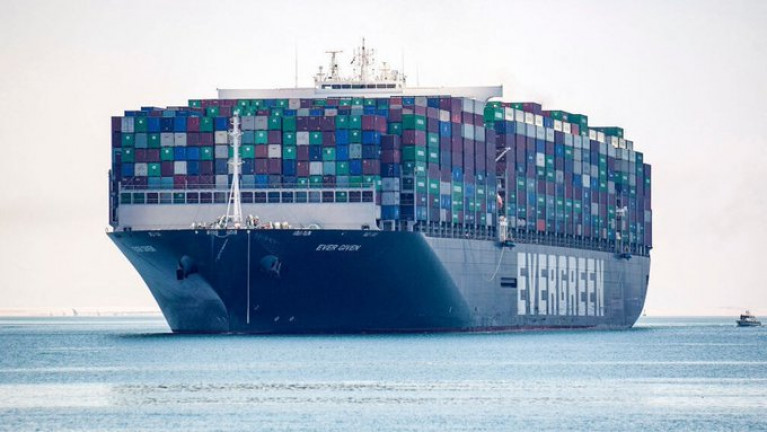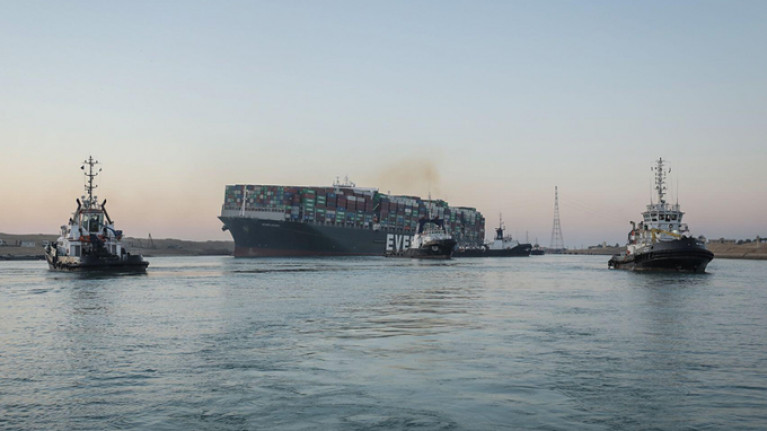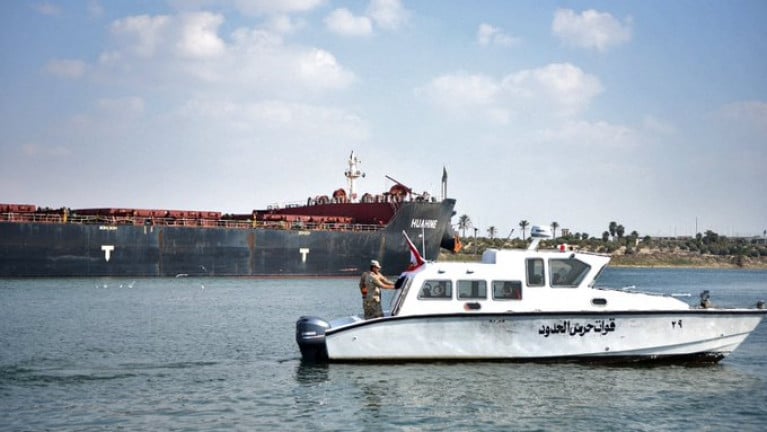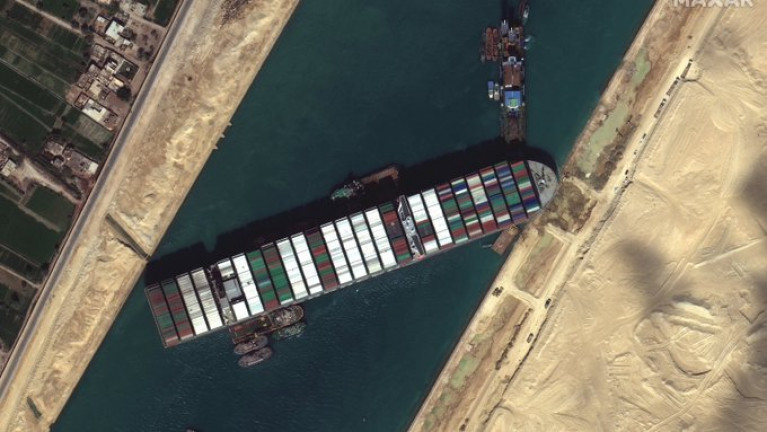Displaying items by tag: Suez Canal
Maersk Files Claim for Blocking of Suez Canal
Maersk shipping group has filed a claim for compensation against the owners and operators of the container ship Ever Given, which blocked the Suez Canal for six days in 2021.
The Danish shipping group, regarded as the largest in the world, is claiming compensation for delays caused by the blockage. It has not disclosed the size of the claim or when it was filed. Industry media ShippingWatch.dk and gCaptain shipping websites have reported that Maersk has raised the claim against Evergreen, the ship’s owners and the technical manager at the Danish Maritime and Commercial High Court, because Maersk suffered losses in connection with Ever Given’s blocking of the Suez Canal.
Ever Given, one of the world’s largest container ships, became jammed across the canal in high winds for six days in March 2021, halting traffic in both directions and disrupting global trade.
Ever Given, one of the world's largest container ships has resumed its journey to leave the Suez Canal, 106 days after becoming wedged across a southern section of the waterway for nearly a week and disrupting global trade.
A Reuters witness on board a tug boat saw the Ever Given start to move north in the Great Bitter Lake (see Monday's 'agreement' story), which separates two sections of the canal and where it has been moored with its Indian crew since being refloated on 29 March.
Canal sources said the vessel would be escorted by two tug boats and guided by two experienced pilots as it makes its way through the canal, one of the world's busiest waterways, towards the Mediterranean Sea.
A ceremony was held at the canal to mark the departure of the ship, which is loaded with about 18,300 containers.
The Ever Given had become grounded in the southernmost, single-lane stretch of the canal on 23 March amid high winds.
RTE News has more on this story.
A long-running dispute about the release of containership Ever Given, as Afloat previously reported, has been resolved and the vessel will resume its voyage this week, more than three months after the incident that blocked the Suez Canal.
“Following the agreement in principle between the parties, and after further meetings with the Suez Canal Authority’s negotiating committee and numerous court hearings, good progress has been made and a formal solution has now been agreed,” the UK P&I Club, the vessel’s insurer, said in a statement.
“Preparations for the release of the vessel will be made and an event marking the agreement will be held at the authority’s headquarters in Ismailia in due course.''
Reuters reports that the SCA will sign the settlement contract on July 7, allowing the ship to resume its voyage. No details of the final settlement were given.
Last month an agreement in principle was reached between the vessels owners and insurers.
More from the SCA here, reports LloydsLoadingList.
The insurer of containership Ever Given said an agreement in principle has been reached to release the ship from the Suez Canal from where Afloat adds, became blocked in March but was eventually freed in a major salvage effort.
As LloydLoadingList reports, the UK P&I Club said the deal followed extensive discussions with the Suez Canal Authority’s negotiating committee in recent weeks.
“Together with the owner and the ship’s other insurers we are now working with the SCA to finalise a signed settlement agreement as soon as possible,” the club said.
“Once the formalities have been dealt with, arrangements for the release of the vessel will be made.”
More on the story here.
Egypt: Suez Canal Authority Says Backlog Cleared
In Egypt, the Suez Canal Authority has said that a shipping traffic jam caused by a giant container vessel getting stuck on the crucial waterway for almost a week has been cleared.
Traffic on the canal, a conduit for over 10% of world trade, began moving again on Monday evening after the 200,000-tonne MV Ever Given was refloated with the help of international salvage experts.
"All the ships waiting in the waterway since the grounding of the... (MV) Ever Given have completed passage," SCA chief Osama Rabie said in a statement by the canal authority.
The wedging of the Japanese-owned, Taiwanese-operated ship had created tailbacks to the north and south totalling over 420 ships, with billions of dollars-worth of cargo.
More here reports RTE News on the Suez shipping incident and impact on Asian-Europe trade.
Suez Ship is Freed at Last
The enormous container ship Ever Given was finally freed this (Monday) afternoon from her global trade-wrecking blockage of the Suez Canal.
After days of struggle, salvage crews freed the giant container ship.
Human error is considered in the cause of the ship’s grounding.
The New York Times has the story here
Suez Canal Blockage? New Container Pyramid Would Add to Egypt’s Historic Tourist Attractions
As the old business school saying has it, there are no problems - there are only fresh opportunities. The acute problem of the relatively rare blockage of the Suez Canal, with the salvors of the 400m Ever Given faced with an order from the President of Egypt to unload the hundreds of containers in the hope of lightening the shop sufficiently to float the ship, would seem to most folk to be an enormous challenge of logistics, fraught with genuine and possibly fatal physical hazards.
But those who have a habit of thinking outside the box (or boxes if you prefer) suggest that, with a bit of imagination, an unexpected benefit can be derived from the situation, and if sufficient sand can be persuaded to settle on it over the years - perhaps held in place with a judicious sprinkling of cement - in a thousand of years’ time archaeologists will have developed a wide range of theories as to how it came to be there in the first place. The reckoning is it will come to be seen as an offshoot of the Cargo Cult of Papua New Guinea.
Crisis on Suez As President of Egypt Orders Ship Cargo Lifted Off As More Tugs Join Operation
Ever Given, the giant container ship remains stuck in the Suez Canal on Sunday after authorities tried and failed to make use of the high tide to free the vessel and reopen the crucial waterway.
Two attempts to free the Ever Given were unsuccessful on Saturday despite hopes the high water level could give the efforts a boost as more than 300 vessels wait to use the canal.
Two additional tugboats are speeding towards the stricken vessel, which has been wedged sideways since Tuesday.
The tugboats will nudge the 400m-long vessel as dredgers continue to vacuum up sand from beneath it and mud caked to its side.
More than 320 ships are waiting to travel through the waterway, either to the Mediterranean or the Red Sea. Dozens of others still listed their destination as the canal, although shippers increasingly appear to be avoiding the passage.
Independent has much more to report on this ongoing development.
While the Evergreen-owned container ship blocking the Suez Canal may be the biggest ship of her kind in the world, canal sailors from many countries have been developing theories as to how best she might be moved, and two Narrowboat navigators on the canal at Runcorn in northwest England, where Cheshire is morphing into Meryseyside, were observed yesterday (Saturday) conducting what they claim to be in effect tank tests as to how best the big ship might be freed.
Their first proposal, that a section should simply be cut out of the middle of the ship to shorten it that crucial amount, is thought to be only a desperate last resort, rather than a serious proposal. Thus further test reports are awaited with interest.
Meanwhile, in Liverpool, it is recalled that, once upon a time when a certain laxative was at its most popular, a large ship went aground in Liverpool Bay and was stuck there for days. On Day 3, a small plane flew up and down overhead, trailing an advertising banner. It said: “Beecham’s Will Shift It”.
Get Suez Ship Afloat - Afloat.ie’s Suggestion
When Lou Grade produced the unsuccessful and ridiculously expensive movie Raise the Titanic, he said afterwards that it would have cost less to lower the Atlantic.
Afloat.ie’s suggestion for the Ever Given blocked in the Suez Canal is the opposite. They should build coffer dams ahead and astern of the Ever Aground, fill up the new “pond” thereby created until the ship floats, straighten her up, and then remove the coffer dams.
The dams should be built far enough from the ship that she can be moved into water of the proper depth, as sand will have built up directly underneath the vessel with all the faffing around by tugs.
And this is NOT an early April Fool.




























































